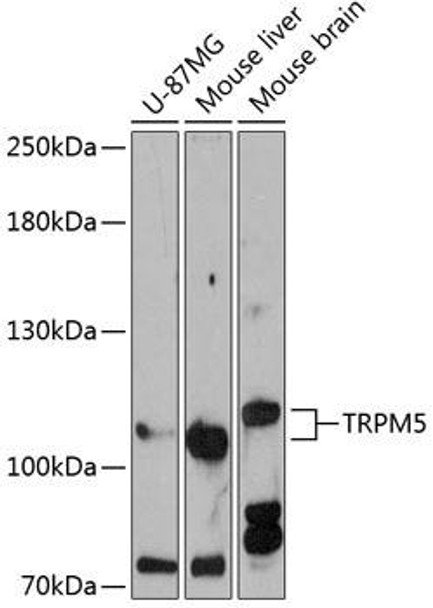Anti-TRPM5 Antibody (CAB12365)
- SKU:
- CAB12365
- Product type:
- Antibody
- Reactivity:
- Human
- Reactivity:
- Mouse
- Host Species:
- Rabbit
- Isotype:
- IgG
- Antibody Type:
- Polyclonal Antibody
- Research Area:
- Signal Transduction
Frequently bought together:
Description
| 抗体名: | Anti-TRPM5 Antibody |
| 抗体コード: | CAB12365 |
| 抗体サイズ: | 20uL, 50uL, 100uL |
| 申し込み: | WB |
| 反応性: | Human, Mouse |
| 宿主種: | Rabbit |
| 免疫原: | Recombinant fusion protein containing a sequence corresponding to amino acids 1026-1165 of human TRPM5 (NP_055370.1). |
| 申し込み: | WB |
| 推奨希釈: | WB 1:500 - 1:2000 |
| 反応性: | Human, Mouse |
| ポジティブサンプル: | U-87MG, Mouse liver, Mouse brain |
| 免疫原: | Recombinant fusion protein containing a sequence corresponding to amino acids 1026-1165 of human TRPM5 (NP_055370.1). |
| 精製方法: | Affinity purification |
| ストレージバッファ: | Store at -20'C. Avoid freeze / thaw cycles. Buffer: PBS with 0.02% sodium azide, 50% glycerol, pH7.3. |
| アイソタイプ: | IgG |
| 順序: | RVFK KEAE HKRE HLER DLPD PLDQ KVVT WETV QKEN FLSK MEKR RRDS EGEV LRKT AHRV DFIA KYLG GLRE QEKR IKCL ESQI NYCS VLVS SVAD VLAQ GGGP RSSQ HCGE GSQL VAAD HRGG LDGW EQPG AGQP PSDT |
| 遺伝子ID: | 29850 |
| Uniprot: | Q9NZQ8 |
| セルラーロケーション: | Cell membrane, Multi-pass membrane protein |
| 計算された分子量: | 97kDa/131kDa |
| 観察された分子量: | 112kDa |
| 同義語: | TRPM5, LTRPC5, MTR1 |
| バックグラウンド: | This gene encodes a member of the transient receptor potential (TRP) protein family, which is a diverse group of proteins with structural features typical of ion channels. This protein plays an important role in taste transduction, and has characteristics of a calcium-activated, non-selective cation channel that carries Na+, K+, and Cs+ ions equally well, but not Ca(2+) ions. It is activated by lower concentrations of intracellular Ca(2+), and inhibited by higher concentrations. It is also a highly temperature-sensitive, heat activated channel showing a steep increase of inward currents at temperatures between 15 and 35 degrees Celsius. This gene is located within the Beckwith-Wiedemann syndrome critical region-1 on chromosome 11p15.5, and has been shown to be imprinted, with exclusive expression from the paternal allele. |
| UniProt Protein Function: | TRPM5: Voltage-modulated Ca(2+)-activated, monovalent cation channel (VCAM) that mediates a transient membrane depolarization and plays a central role in taste transduction. Monovalent- specific, non-selective cation channel that mediates the transport of Na(+), K(+) and Cs(+) ions equally well. Activated directly by increases in intracellular Ca(2+), but is impermeable to it. Gating is voltage-dependent and displays rapid activation and deactivation kinetics upon channel stimulation even during sustained elevations in Ca(2+). Also activated by a fast intracellular Ca(2+) increase in response to inositol 1,4,5- triphosphate-producing receptor agonists. The channel is blocked by extracellular acidification. External acidification has 2 effects, a fast reversible block of the current and a slower irreversible enhancement of current inactivation. Is a highly temperature-sensitive, heat activated channel showing a steep increase of inward currents at temperatures between 15 and 35 degrees Celsius. Heat activation is due to a shift of the voltage- dependent activation curve to negative potentials. Activated by arachidonic acid in vitro. May be involved in perception of bitter, sweet and umami tastes. May also be involved in sensing semiochemicals. Belongs to the transient receptor (TC 1.A.4) family. LTrpC subfamily. TRPM5 sub-subfamily. 3 isoforms of the human protein are produced by alternative splicing. |
| UniProt Protein Details: | Protein type:Membrane protein, integral; Membrane protein, multi-pass Chromosomal Location of Human Ortholog: 11p15.5 Cellular Component: plasma membrane Molecular Function:ion channel activity; sodium channel activity |
| NCBI Summary: | This gene encodes a member of the transient receptor potential (TRP) protein family, which is a diverse group of proteins with structural features typical of ion channels. This protein plays an important role in taste transduction, and has characteristics of a calcium-activated, non-selective cation channel that carries Na+, K+, and Cs+ ions equally well, but not Ca(2+) ions. It is activated by lower concentrations of intracellular Ca(2+), and inhibited by higher concentrations. It is also a highly temperature-sensitive, heat activated channel showing a steep increase of inward currents at temperatures between 15 and 35 degrees Celsius. This gene is located within the Beckwith-Wiedemann syndrome critical region-1 on chromosome 11p15.5, and has been shown to be imprinted, with exclusive expression from the paternal allele. [provided by RefSeq, Oct 2010] |
| UniProt Code: | Q9NZQ8 |
| NCBI GenInfo Identifier: | 74753086 |
| NCBI Gene ID: | 29850 |
| NCBI Accession: | Q9NZQ8.1 |
| UniProt Secondary Accession: | Q9NZQ8,Q52LU2, Q9NY34, A6NHS0, |
| UniProt Related Accession: | Q9NZQ8 |
| Molecular Weight: | 131kDa |
| NCBI Full Name: | Transient receptor potential cation channel subfamily M member 5 |
| NCBI Synonym Full Names: | transient receptor potential cation channel subfamily M member 5 |
| NCBI Official Symbol: | TRPM5 |
| NCBI Official Synonym Symbols: | MTR1; LTRPC5 |
| NCBI Protein Information: | transient receptor potential cation channel subfamily M member 5 |
| UniProt Protein Name: | Transient receptor potential cation channel subfamily M member 5 |
| UniProt Synonym Protein Names: | Long transient receptor potential channel 5; LTrpC-5; LTrpC5; MLSN1- and TRP-related gene 1 protein |
| Protein Family: | Transient receptor potential cation channel subfamily |
| UniProt Gene Name: | TRPM5 |
View AllClose


